 By Bob Currie, Vessel Examiner
By Bob Currie, Vessel Examiner
United States Coast Guard Auxiliary Station Galveston Flotilla.
Summary of Part 1
The best way to handle a person in the water (PIW) situation is to operate in a manner that reduces the possibility of it even happening. This includes keeping a tight ship, ensuring that all persons are properly seated while underway and also includes notifying your passengers before making sudden changes in speed and direction. In addition, you can train your passengers to assist you by having them shout “MAN OVERBOARD!” and pointing toward the PIW if they see someone go overboard. If you end up with a PIW situation, knowing what to do as far as maneuvering back to the PIW can help with recovery. It takes only a small amount of time to instruct your passengers.
The Station Galveston Flotilla of the US Coast Guard Auxiliary operates out of the USCG Station Galveston base on Galveston Island. They provide assistance to the Coast Guard by providing maritime observation patrols in Galveston Bay; by providing recreational boating vessel safety checks; and by working alongside Coast Guard members in maritime accident investigation, small boat training, watch standing, and property administration.
First Steps When a PIW Situation Occurs
I mentioned last week that boat operators should practice handling a PIW situation. For me, that often occurs when my favorite fishing hat blows off when I am running across the water. I practice my turns and I practice marking the position of my hat with my GPS. There is no single correct order in which the steps should be executed. Everything depends on the situation at hand. Safety of the boat operator and passengers should guide any response to a PIW. First steps include the following:
- Announce a PIW loudly and repeatedly by shouting “MAN OVERBOARD!” Include the location the person fell overboard (port/starboard side, bow, stern).
- Throw a ring buoy or throw cushion overboard to mark the site and give the PIW something to swim to for extra flotation.
- Maintain sight of and continuously point (open handed) to the PIW while carefully moving to a position in sight of the boat operator so they can use your pointing arm to aid in maneuvering to recover the PIW.
- Use the Man Overboard procedure on your GPS to mark the position of the PIW. The sooner you perform this procedure, the more accurate the created waypoint will be. Practice creating MOB waypoints so you won’t have to search your GPS screen for the button to push.
If Recovery Is Not Immediate
Do not assume that recovery will be immediate. When the waves are one foot or higher, it is easy to lose sight of a PIW, even when they are relatively close to your boat. If the person is not wearing a life jacket, it is even harder to keep them in view or to even spot them in the water. Therefore, you must plan for a delayed recovery even as the situation is occurring. Hit that Man Overboard button on your GPS. People often tell me that they don’t need GPS because they never get out of sight of land. That GPS has more than one use besides navigating home. It gives you your latitude and longitude, which is critical information when you need assistance on the water. It is also critical equipment when you have a PIW incident. Tossing a throw cushion in the water is helpful, but having an exact position to return to if unable to locate the PIW visually is key to a successful LIVE recovery. If your boat is not equipped with GPS, then try to use visual landmarks to help identify the position.
Calling for Help and Providing Warning
There are two basic methods of calling for help and providing warning to other nearby vessels that a danger exists in the immediate area. The first method is to use your sound producing device, whether that is a horn or a whistle. Sounding five or more short blasts on the horn or with a whistle alerts other vessels that a danger exists, such as a man overboard. The second method is to use your marine VHF/FM radio to transmit the emergency call signal Pan (pronounced pahn). The signal should be transmitted in sets of two for three sets: PAN-PAN…PAN-PAN…PAN-PAN, on channel 16. This should be followed with the boat’s identification, position, and a brief description of the situation. “MAYDAY” should not be used, as it is to be used only when threatened by grave and imminent danger. When other vessels are nearby, both methods should be used. When no other vessels are in sight, use the PAN-PAN radio procedure. Once the person is recovered, be sure to announce that fact on the radio to inform the Coast Guard and other vessels. Once you locate the PIW, it is time to decide which approach to use to recover the PIW. There are three basic approaches:
- Leeward approach (against the wind and current)
- Windward approach (with the wind and current)
- Windward to leeward approach of multiple PIW
Leeward Approach
The leeward approach is performed with the bow facing into the greatest force of the oncoming resistance at the time of the recovery. 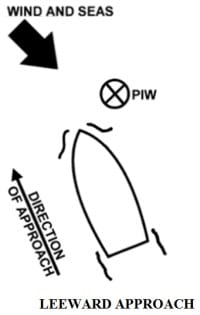 This may be the wind, current, seas, or any combination of the three. There are times when the wind and current are coming from different directions. The leeward approach uses vessel power to approach the PIW. The leeward approach procedure follows:
This may be the wind, current, seas, or any combination of the three. There are times when the wind and current are coming from different directions. The leeward approach uses vessel power to approach the PIW. The leeward approach procedure follows:
-
- Select the heading that will best ease the approach, and balance the effect of any swell that may be present. Keep in mind that a large swell could easily carry you past the PIW just as they come alongside.
- Make the approach rapidly, but as the boat nears the person, reduce wake and slow the boat enough to stop headway with a short backing down burst. The PIW should be next to the recovery area on the boat and the boat should be dead in the water. Warn passengers on the boat to maintain a good hold during the maneuver.
- Place the engine in Neutral and, when the person overboard is alongside, have the crew make the recovery.
- For better control during the approach, try to make all pickups with your boat heading into the prevailing weather and sea conditions.
- Take care not to overrun the person overboard or to have so much headway on that the boat drifts beyond the PIW.
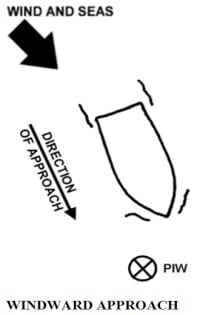
- If the PIW does drift aft of the boat, do not back down to effect the recovery. The propeller could injure the person. The best course of action should the boat overshoot the PIW is to go around again and make another approach.
Windward Approach
The Windward approach is performed with the wind coming from behind the boat, when the PIW is in a confined space, and a leeward approach is impossible. The following should be used for a windward approach:
- The operator must maneuver into position upwind and up current from the PIW.
- Place the engine in neutral.
- Drift down to the person.
- Ensure the boat drifts so it places the PIW along the recovery side, but do not allow the boat to drift over the person.
Windward to Leeward Approach of Multiple PIW
Depending on skill and experience, a combination of windward and leeward approaches may be necessary to pick up multiple PIW, such as in the case of another vessel capsizing.
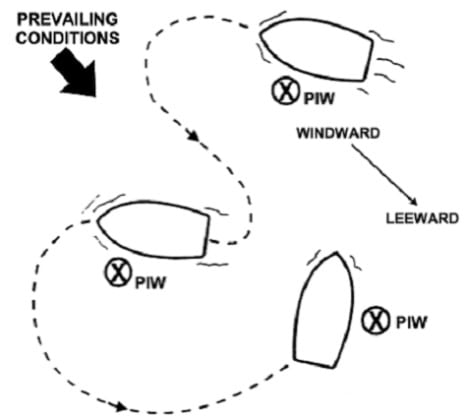
With any approach and recovery, it is important to keep the weight in the boat as evenly distributed as possible during the approach and recovery. An unbalanced boat is at risk of capsizing during a PIW recovery.
The Low Visibility Approach
During low visibility and night operations, the same general procedures apply. The person seeing another person go overboard shouts “MAN OVERBOARD!” and tosses a flotation device (preferably with a strobe light) overboard to mark the position. The boat operator presses the Man Overboard button on the GPS, sounds the Danger signal, and goes to the PIW using one of the following turns:
- Anderson Turn
- Racetrack Turn
- Williamson Turn
Anderson Turn
An advantage of the Anderson Turn is that it is the fastest recovery method. A disadvantage is that it is not meant for use by a single engine boat. 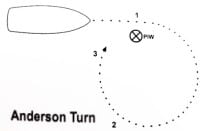 The Anderson Turn is performed using the following procedure:
The Anderson Turn is performed using the following procedure:
- Put the rudder over full in the direction corresponding to the side from which the person fell. Increase power on the outboard engine only.
- When about 2/3 of the way around, back the inboard engine 2/3 or full.
- Stop engines when the PIW is within 15 degrees of the bow.
- Ease the rudder and back the engines as required to attain the proper final position.
Racetrack Turn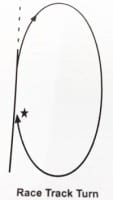
The final straight leg approach of the Racetrack Turn helps for a more calculable approach. The Racetrack Turn is performed using the following procedure:
- Put the rudder over full in the direction corresponding to the side from which the person fell and increase speed (if conditions permit).
- Use full rudder to turn to the reciprocal of the original course.
- Steady up this course for a short distance, then use full rudder to turn to the person overboard.
Williamson Turn
If a person falls overboard during periods of darkness or restricted visibility, and the exact time of the incident is unknown, use the Williamson Turn to 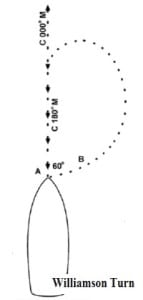 search for the person overboard. The advantage of the Williamson Turn is that it will put the vessel on a reciprocal course on its exact original track. Use the following procedure:
search for the person overboard. The advantage of the Williamson Turn is that it will put the vessel on a reciprocal course on its exact original track. Use the following procedure:
- Mark the original course (for example, 000 degrees) when the alarm was initiated by making a Man Overboard waypoint on your GPS and by putting a ring buoy or other float overboard.
- Alter the course 60 degrees to port or starboard from the original course. Do NOT alter your speed during a Williams Turn.
- When the compass point reaches the 60 degrees mark, turn the rudder to the opposite direction until the reciprocal course of the original course, in this case 180 degrees (180 degrees is the exact opposite direction from 000 degrees) is reached.
- Search along the reciprocal course until a point is reached where it is known that the PIW was still aboard.
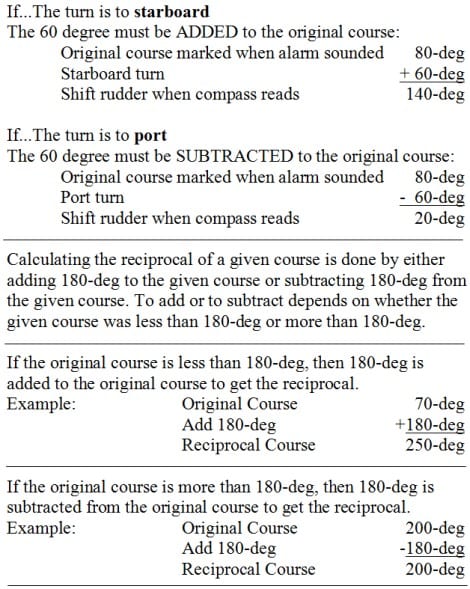
Summary
There are different methods for approaching a person in the water in order to recover them after they have fallen overboard. There are also different methods of turning the boat to increase the odds of locating the PIW when they can’t be located right away. If you cannot maintain sight of the PIW, then follow one of the turn procedures shown above to increase the odds of finding the PIW. The goal is to make a turn that puts you on a reciprocal course, that is, a course opposite in direction from the original course. It is important to practice the PIW procedures, including the turns, making GPS waypoints, and keeping an object such as a hat in the water in sight so that if you ever have to perform the PIW procedure for real, you will be able to do it with confidence.
For more information on boating safety, please visit the Official Website of the U.S. Coast Guard’s Boating Safety Division at www.uscgboating.org. Questions about the US Coast Guard Auxiliary or our free Vessel Safety Check program may be directed to me at [email protected]. I am available to perform free Vessel Safety Checks, and I will come to your location to perform them. SAFE BOATING!
[6-3-2019]

 Posted in
Posted in 























